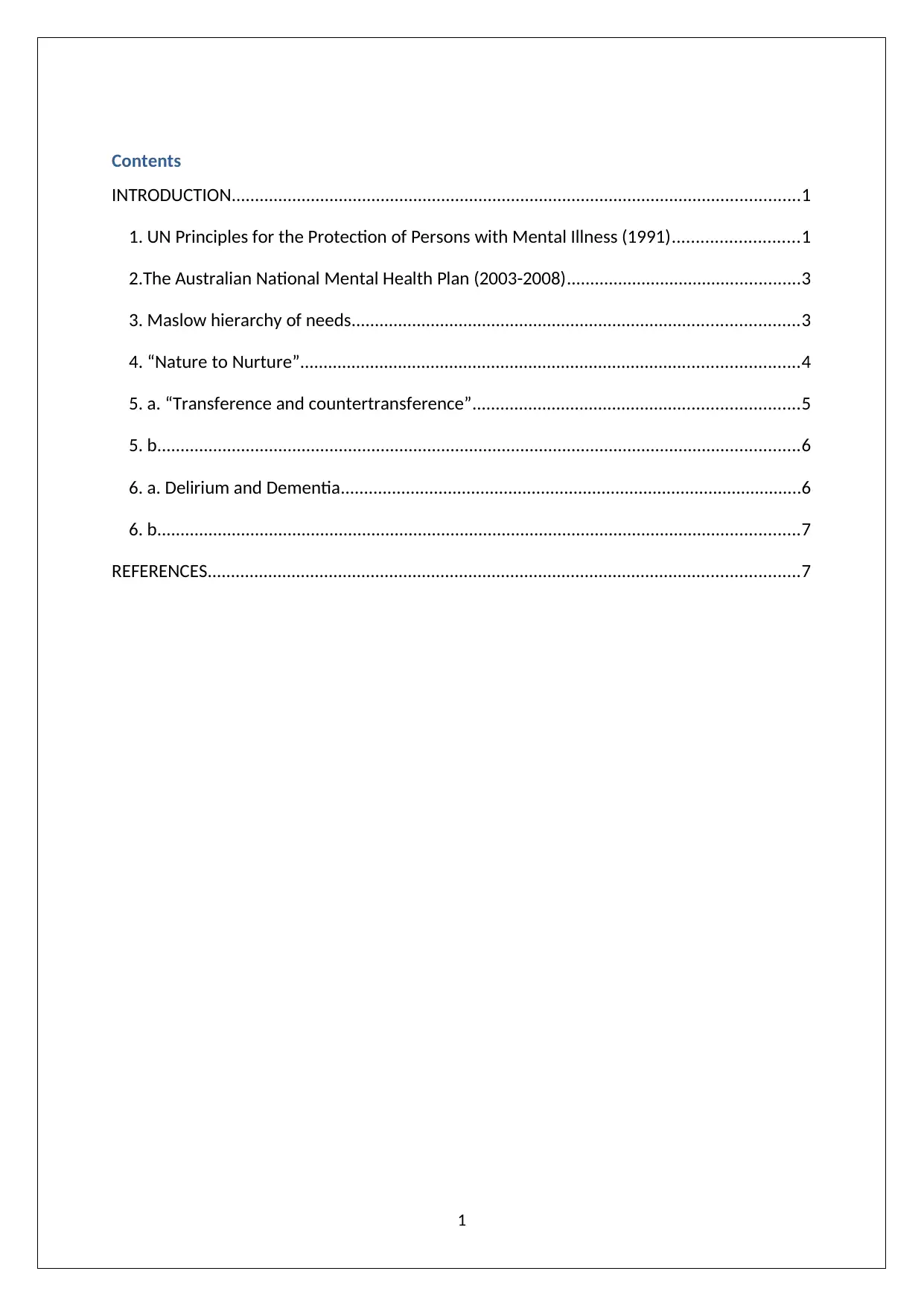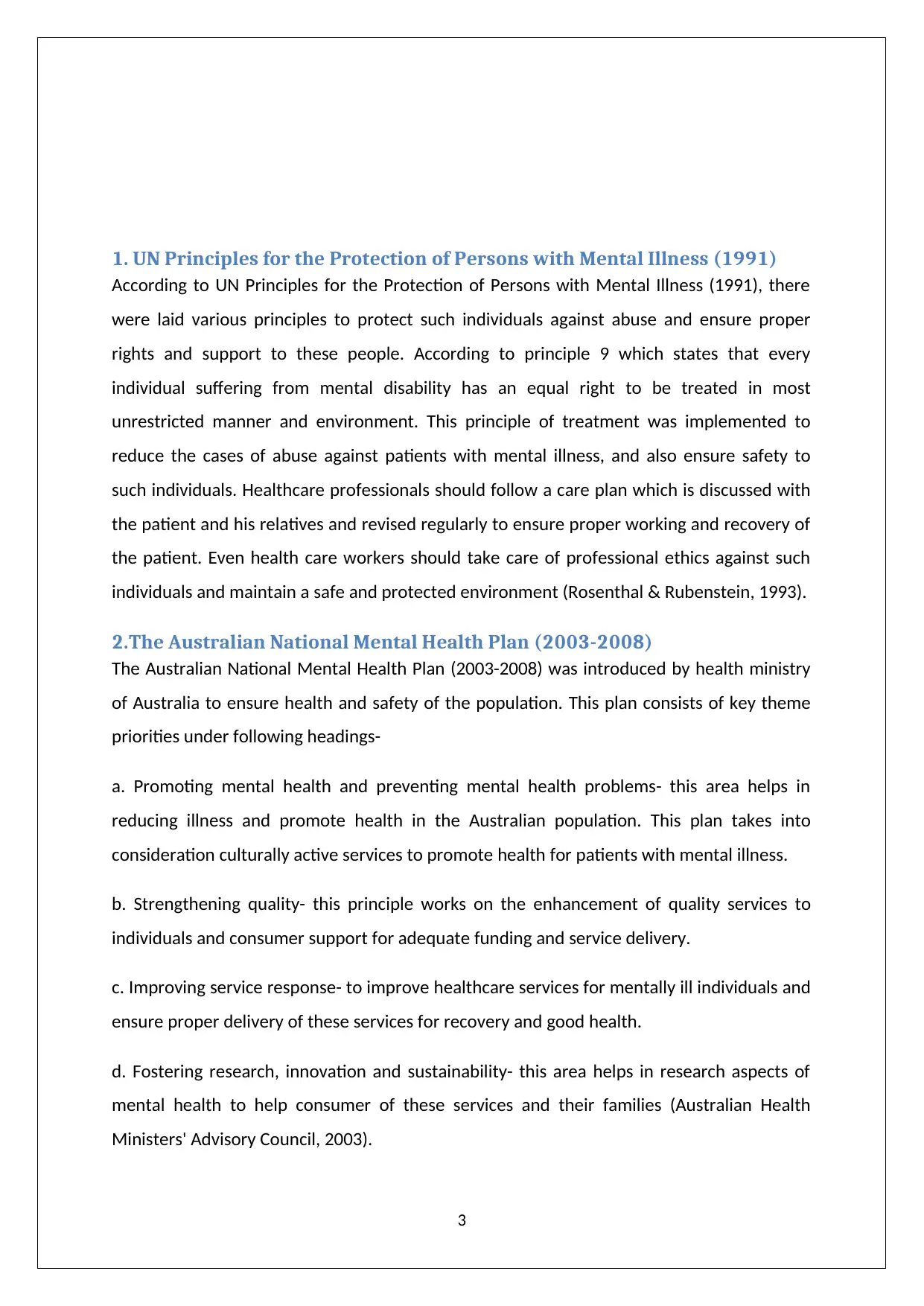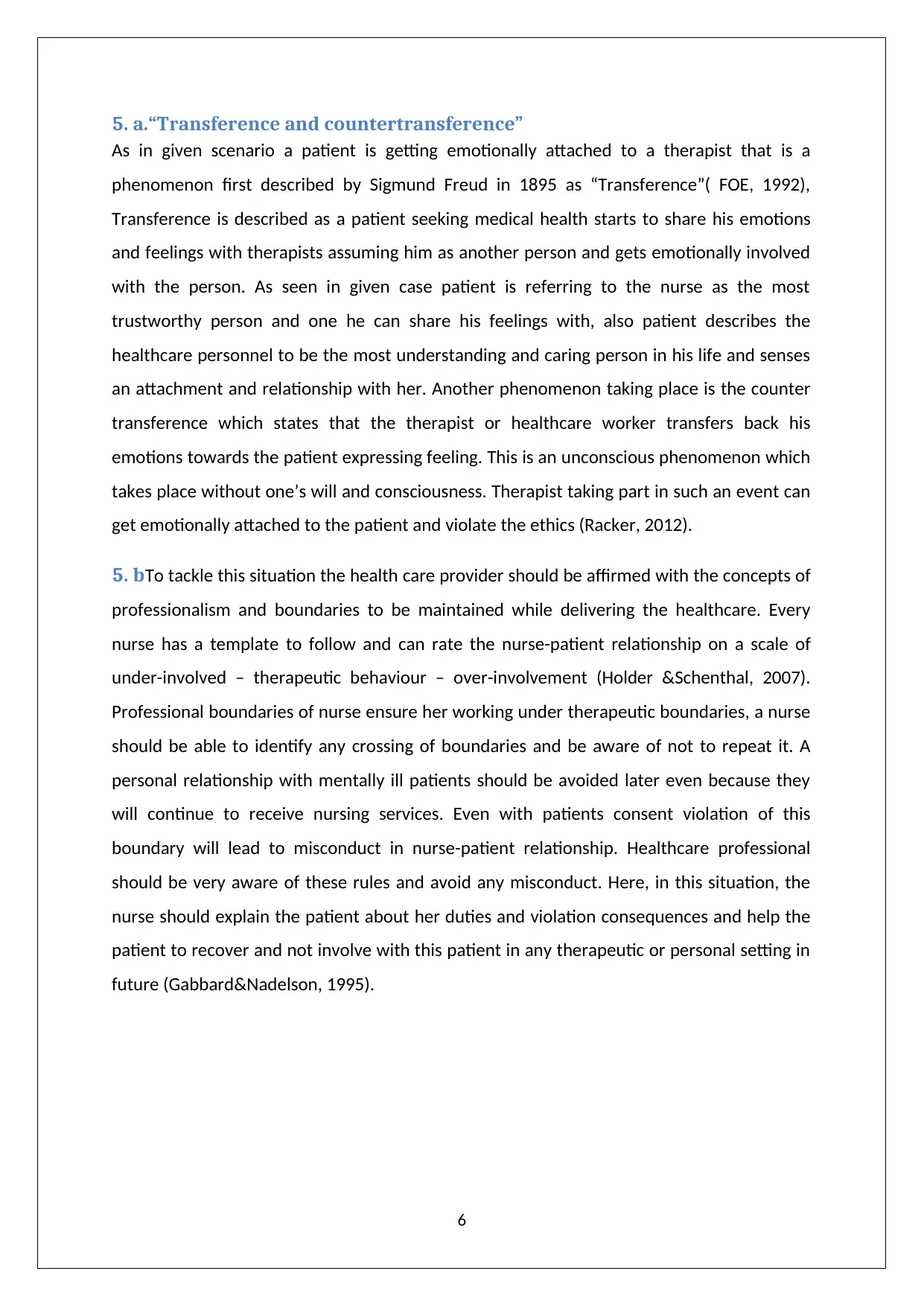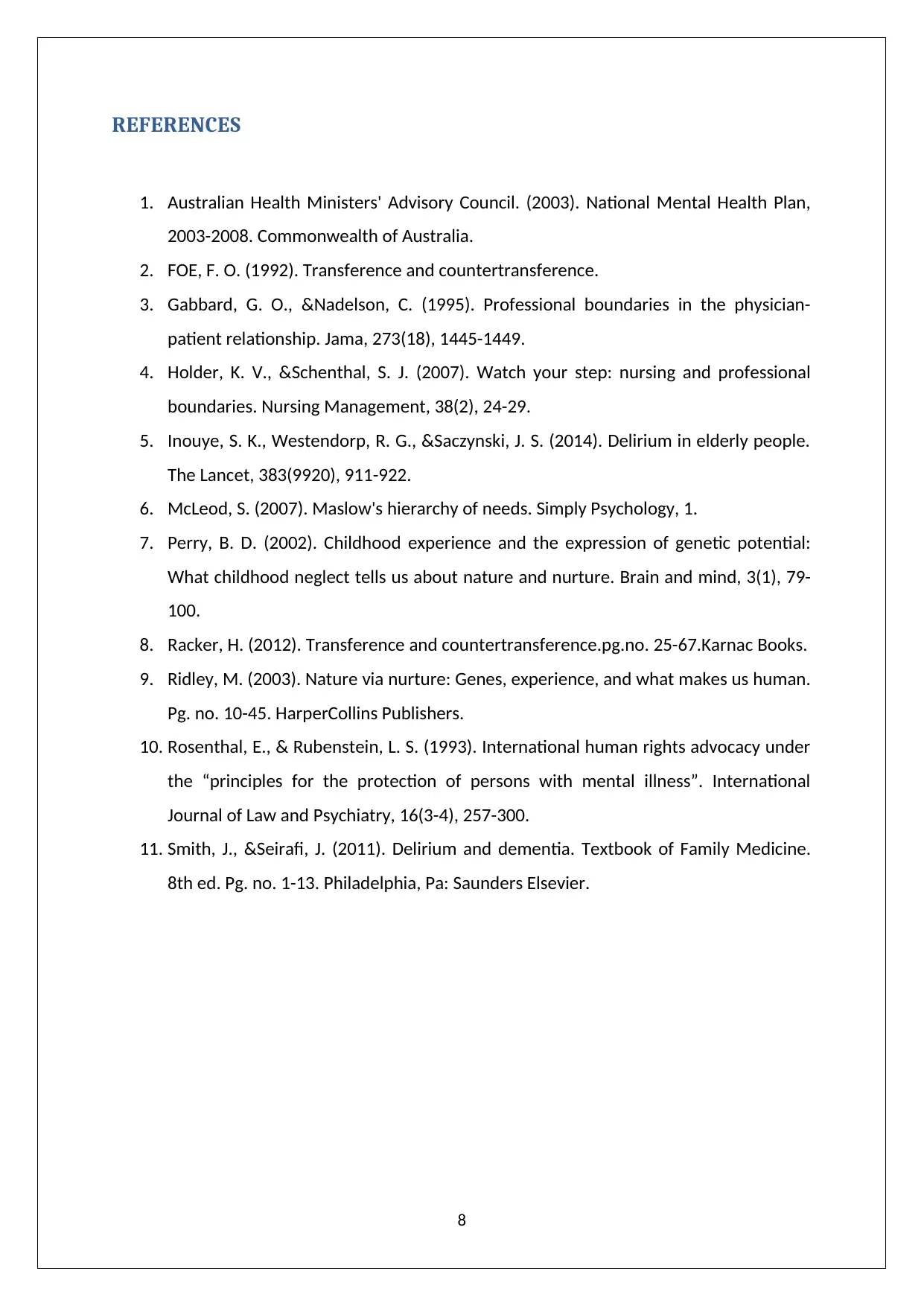Mental Health Nursing: UN Principles, Australian Plan, and Analysis
VerifiedAdded on 2024/04/26
|8
|1986
|208
Report
AI Summary
This report provides an overview of essential aspects of mental health nursing, beginning with the UN Principles for the Protection of Persons with Mental Illness (1991), which emphasizes the right to unrestricted treatment and protection from abuse. It then discusses the Australian National Mental Health Plan (2003-2008), highlighting its key themes such as promoting mental health, strengthening service quality, improving service response, and fostering research. The report further examines Maslow's hierarchy of needs in the context of mental health, focusing on physiological, safety, and belongingness needs. The 'Nature to Nurture' concept is explored, along with discussions on transference and countertransference in therapeutic relationships, emphasizing the importance of professional boundaries. Finally, the report differentiates between delirium and dementia, outlining their causes and key differences. The document includes relevant references to support its analysis and conclusions.

Contents
INTRODUCTION..........................................................................................................................1
1. UN Principles for the Protection of Persons with Mental Illness (1991)...........................1
2.The Australian National Mental Health Plan (2003-2008)..................................................3
3. Maslow hierarchy of needs................................................................................................3
4. “Nature to Nurture”...........................................................................................................4
5. a. “Transference and countertransference”......................................................................5
5. b..........................................................................................................................................6
6. a. Delirium and Dementia...................................................................................................6
6. b..........................................................................................................................................7
REFERENCES...............................................................................................................................7
1
INTRODUCTION..........................................................................................................................1
1. UN Principles for the Protection of Persons with Mental Illness (1991)...........................1
2.The Australian National Mental Health Plan (2003-2008)..................................................3
3. Maslow hierarchy of needs................................................................................................3
4. “Nature to Nurture”...........................................................................................................4
5. a. “Transference and countertransference”......................................................................5
5. b..........................................................................................................................................6
6. a. Delirium and Dementia...................................................................................................6
6. b..........................................................................................................................................7
REFERENCES...............................................................................................................................7
1
Paraphrase This Document
Need a fresh take? Get an instant paraphrase of this document with our AI Paraphraser

INTRODUCTION
Mental disorders are increasing in population at an alarming rate. Taking care of people
experiencing such disorders is very essential and critical. Nursing interventions are solely a
part of care planning for such individuals. It is every individual’s right to gain support and
help who experience retarded mental ability. Following various policies and procedures to
ensure proper and protected living of disabled individuals and support to spend qualitative
lifespan is what a healthcare nurse / professional oath to accomplish.
2
Mental disorders are increasing in population at an alarming rate. Taking care of people
experiencing such disorders is very essential and critical. Nursing interventions are solely a
part of care planning for such individuals. It is every individual’s right to gain support and
help who experience retarded mental ability. Following various policies and procedures to
ensure proper and protected living of disabled individuals and support to spend qualitative
lifespan is what a healthcare nurse / professional oath to accomplish.
2

1. UN Principles for the Protection of Persons with Mental Illness (1991)
According to UN Principles for the Protection of Persons with Mental Illness (1991), there
were laid various principles to protect such individuals against abuse and ensure proper
rights and support to these people. According to principle 9 which states that every
individual suffering from mental disability has an equal right to be treated in most
unrestricted manner and environment. This principle of treatment was implemented to
reduce the cases of abuse against patients with mental illness, and also ensure safety to
such individuals. Healthcare professionals should follow a care plan which is discussed with
the patient and his relatives and revised regularly to ensure proper working and recovery of
the patient. Even health care workers should take care of professional ethics against such
individuals and maintain a safe and protected environment (Rosenthal & Rubenstein, 1993).
2.The Australian National Mental Health Plan (2003-2008)
The Australian National Mental Health Plan (2003-2008) was introduced by health ministry
of Australia to ensure health and safety of the population. This plan consists of key theme
priorities under following headings-
a. Promoting mental health and preventing mental health problems- this area helps in
reducing illness and promote health in the Australian population. This plan takes into
consideration culturally active services to promote health for patients with mental illness.
b. Strengthening quality- this principle works on the enhancement of quality services to
individuals and consumer support for adequate funding and service delivery.
c. Improving service response- to improve healthcare services for mentally ill individuals and
ensure proper delivery of these services for recovery and good health.
d. Fostering research, innovation and sustainability- this area helps in research aspects of
mental health to help consumer of these services and their families (Australian Health
Ministers' Advisory Council, 2003).
3
According to UN Principles for the Protection of Persons with Mental Illness (1991), there
were laid various principles to protect such individuals against abuse and ensure proper
rights and support to these people. According to principle 9 which states that every
individual suffering from mental disability has an equal right to be treated in most
unrestricted manner and environment. This principle of treatment was implemented to
reduce the cases of abuse against patients with mental illness, and also ensure safety to
such individuals. Healthcare professionals should follow a care plan which is discussed with
the patient and his relatives and revised regularly to ensure proper working and recovery of
the patient. Even health care workers should take care of professional ethics against such
individuals and maintain a safe and protected environment (Rosenthal & Rubenstein, 1993).
2.The Australian National Mental Health Plan (2003-2008)
The Australian National Mental Health Plan (2003-2008) was introduced by health ministry
of Australia to ensure health and safety of the population. This plan consists of key theme
priorities under following headings-
a. Promoting mental health and preventing mental health problems- this area helps in
reducing illness and promote health in the Australian population. This plan takes into
consideration culturally active services to promote health for patients with mental illness.
b. Strengthening quality- this principle works on the enhancement of quality services to
individuals and consumer support for adequate funding and service delivery.
c. Improving service response- to improve healthcare services for mentally ill individuals and
ensure proper delivery of these services for recovery and good health.
d. Fostering research, innovation and sustainability- this area helps in research aspects of
mental health to help consumer of these services and their families (Australian Health
Ministers' Advisory Council, 2003).
3
⊘ This is a preview!⊘
Do you want full access?
Subscribe today to unlock all pages.

Trusted by 1+ million students worldwide

3.Maslow hierarchy of needs
Maslow hierarchy of needs stated that every person has a specific set of needs which are
distributed in levels and some needs are important than others. According to Maslow, there
are 5 kinds of needs a person requires from which Physical need is foremost important for
every individual. Physiological need being the first most level of hierarchy includes food,
nutrition, shelter, sleep and warmth. Another level indicates Safety needs which ensure
protection from all the elements in society and life. The third level consists of Love and
Belongingness needs which enables one to attain love, friendship, trust and belongingness
in their life. These three needs described by Maslow are important for life and living. He also
described two more needs as Esteem that is esteem for self and for others and Self-
actualization that enables one of realizing actual self-potential.
(online source- https://www.simplypsychology.org/maslow.html ).
For a mentally ill patient deficit needs to be fulfilled are utmost important that includes 1.
Physiological needs 2. Safety needs and 3. Need for love and belongingness. As a healthcare
professional taking care of individual’s physiological needs that are providing proper diet
and hydration to them also shelter and sleep for better recovery. One should take care of
providing a protected environment for such individuals and ensure their rights to safety
from every element and abuse. The third need of love and belongingness is to be promoted
to such patients by ensuring a caring and friendly environment to them that will enable
them to trust people and recover to attain better health (McLeod, 2007).
4
Maslow hierarchy of needs stated that every person has a specific set of needs which are
distributed in levels and some needs are important than others. According to Maslow, there
are 5 kinds of needs a person requires from which Physical need is foremost important for
every individual. Physiological need being the first most level of hierarchy includes food,
nutrition, shelter, sleep and warmth. Another level indicates Safety needs which ensure
protection from all the elements in society and life. The third level consists of Love and
Belongingness needs which enables one to attain love, friendship, trust and belongingness
in their life. These three needs described by Maslow are important for life and living. He also
described two more needs as Esteem that is esteem for self and for others and Self-
actualization that enables one of realizing actual self-potential.
(online source- https://www.simplypsychology.org/maslow.html ).
For a mentally ill patient deficit needs to be fulfilled are utmost important that includes 1.
Physiological needs 2. Safety needs and 3. Need for love and belongingness. As a healthcare
professional taking care of individual’s physiological needs that are providing proper diet
and hydration to them also shelter and sleep for better recovery. One should take care of
providing a protected environment for such individuals and ensure their rights to safety
from every element and abuse. The third need of love and belongingness is to be promoted
to such patients by ensuring a caring and friendly environment to them that will enable
them to trust people and recover to attain better health (McLeod, 2007).
4
Paraphrase This Document
Need a fresh take? Get an instant paraphrase of this document with our AI Paraphraser

4.“Nature to Nurture”
“Nature to Nurture” is a phrase used to determine that whether the characteristic an
individual possesses is inherited genetically (that is due to nature or genetic predominance)
or is nurtured by the behaviour influenced by external forces and inbuilt through life
experiences (Ridley, 2003). This is a debate about characteristics of an individual to be
linked by heritance or nurtured by the environment. Some factors such as eye colour, hair
texture, complexion etc. are the characteristics of an individual which are inherited, even
some diseases like cancer, syndromes and mental sickness of some kinds are to be
genetically linked but when the differences in behaviour towards psychology in child and
adult stages is referred than it is seen due to learned and acquired behaviour which results
in nurturing phenomenon. Due to wide studies, it is seen that nature and nurture are both
essential and correlated phenomenon for individual’s behaviour and one cannot be lagged
for another (Perry, 2002).
(online source- http://slideplayer.com/slide/10719883/ ).
5
“Nature to Nurture” is a phrase used to determine that whether the characteristic an
individual possesses is inherited genetically (that is due to nature or genetic predominance)
or is nurtured by the behaviour influenced by external forces and inbuilt through life
experiences (Ridley, 2003). This is a debate about characteristics of an individual to be
linked by heritance or nurtured by the environment. Some factors such as eye colour, hair
texture, complexion etc. are the characteristics of an individual which are inherited, even
some diseases like cancer, syndromes and mental sickness of some kinds are to be
genetically linked but when the differences in behaviour towards psychology in child and
adult stages is referred than it is seen due to learned and acquired behaviour which results
in nurturing phenomenon. Due to wide studies, it is seen that nature and nurture are both
essential and correlated phenomenon for individual’s behaviour and one cannot be lagged
for another (Perry, 2002).
(online source- http://slideplayer.com/slide/10719883/ ).
5

5. a.“Transference and countertransference”
As in given scenario a patient is getting emotionally attached to a therapist that is a
phenomenon first described by Sigmund Freud in 1895 as “Transference”( FOE, 1992),
Transference is described as a patient seeking medical health starts to share his emotions
and feelings with therapists assuming him as another person and gets emotionally involved
with the person. As seen in given case patient is referring to the nurse as the most
trustworthy person and one he can share his feelings with, also patient describes the
healthcare personnel to be the most understanding and caring person in his life and senses
an attachment and relationship with her. Another phenomenon taking place is the counter
transference which states that the therapist or healthcare worker transfers back his
emotions towards the patient expressing feeling. This is an unconscious phenomenon which
takes place without one’s will and consciousness. Therapist taking part in such an event can
get emotionally attached to the patient and violate the ethics (Racker, 2012).
5. bTo tackle this situation the health care provider should be affirmed with the concepts of
professionalism and boundaries to be maintained while delivering the healthcare. Every
nurse has a template to follow and can rate the nurse-patient relationship on a scale of
under-involved – therapeutic behaviour – over-involvement (Holder &Schenthal, 2007).
Professional boundaries of nurse ensure her working under therapeutic boundaries, a nurse
should be able to identify any crossing of boundaries and be aware of not to repeat it. A
personal relationship with mentally ill patients should be avoided later even because they
will continue to receive nursing services. Even with patients consent violation of this
boundary will lead to misconduct in nurse-patient relationship. Healthcare professional
should be very aware of these rules and avoid any misconduct. Here, in this situation, the
nurse should explain the patient about her duties and violation consequences and help the
patient to recover and not involve with this patient in any therapeutic or personal setting in
future (Gabbard&Nadelson, 1995).
6
As in given scenario a patient is getting emotionally attached to a therapist that is a
phenomenon first described by Sigmund Freud in 1895 as “Transference”( FOE, 1992),
Transference is described as a patient seeking medical health starts to share his emotions
and feelings with therapists assuming him as another person and gets emotionally involved
with the person. As seen in given case patient is referring to the nurse as the most
trustworthy person and one he can share his feelings with, also patient describes the
healthcare personnel to be the most understanding and caring person in his life and senses
an attachment and relationship with her. Another phenomenon taking place is the counter
transference which states that the therapist or healthcare worker transfers back his
emotions towards the patient expressing feeling. This is an unconscious phenomenon which
takes place without one’s will and consciousness. Therapist taking part in such an event can
get emotionally attached to the patient and violate the ethics (Racker, 2012).
5. bTo tackle this situation the health care provider should be affirmed with the concepts of
professionalism and boundaries to be maintained while delivering the healthcare. Every
nurse has a template to follow and can rate the nurse-patient relationship on a scale of
under-involved – therapeutic behaviour – over-involvement (Holder &Schenthal, 2007).
Professional boundaries of nurse ensure her working under therapeutic boundaries, a nurse
should be able to identify any crossing of boundaries and be aware of not to repeat it. A
personal relationship with mentally ill patients should be avoided later even because they
will continue to receive nursing services. Even with patients consent violation of this
boundary will lead to misconduct in nurse-patient relationship. Healthcare professional
should be very aware of these rules and avoid any misconduct. Here, in this situation, the
nurse should explain the patient about her duties and violation consequences and help the
patient to recover and not involve with this patient in any therapeutic or personal setting in
future (Gabbard&Nadelson, 1995).
6
⊘ This is a preview!⊘
Do you want full access?
Subscribe today to unlock all pages.

Trusted by 1+ million students worldwide

6. a. Delirium and Dementia
Delirium and Dementia are different entities with similar behavioural changes. It is difficult
to differentiate in both but according to the onset and time of progress; one can
differentiate between the two. Delirium is state of confusion and inability to coherent the
thinking, it can be sudden as increased agitation or confusion in evening referred as “sun-
downing”. Whereas dementia is missing one’s memory and forgetting about various aspects
which will progress over time slowly and will be evident over months or years. Delirium can
go undiagnosed in early stages of dementia, sudden confusion over time of a day and
inability to concentrate can be thought as part of dementia but is a different phenomenon.
The thin line of difference between delirium and dementia is inattention of an individual
towards the two. Fluctuation is another difference between dementia and delirium where a
person feels fluctuation in symptoms of delirium whereas in dementia a person will have
constant parts of a day (Smith & Seirafi, 2011).
6. b. The cause of delirium is due to impaired neurotransmission in the brain. Two reasons
widely seen for increased cases of delirium in an elderly person is firstly old age is a risk
factor for delirium as in older age the tendency of brain cells to work efficiently and
proactively reduces and can cause mental deficits. Another reason described can be as in
early age to support body functioning and life elder person take various medications which
can induce delirium as an effect (Inouye, Westendorp&Saczynski, 2014).
7
Delirium and Dementia are different entities with similar behavioural changes. It is difficult
to differentiate in both but according to the onset and time of progress; one can
differentiate between the two. Delirium is state of confusion and inability to coherent the
thinking, it can be sudden as increased agitation or confusion in evening referred as “sun-
downing”. Whereas dementia is missing one’s memory and forgetting about various aspects
which will progress over time slowly and will be evident over months or years. Delirium can
go undiagnosed in early stages of dementia, sudden confusion over time of a day and
inability to concentrate can be thought as part of dementia but is a different phenomenon.
The thin line of difference between delirium and dementia is inattention of an individual
towards the two. Fluctuation is another difference between dementia and delirium where a
person feels fluctuation in symptoms of delirium whereas in dementia a person will have
constant parts of a day (Smith & Seirafi, 2011).
6. b. The cause of delirium is due to impaired neurotransmission in the brain. Two reasons
widely seen for increased cases of delirium in an elderly person is firstly old age is a risk
factor for delirium as in older age the tendency of brain cells to work efficiently and
proactively reduces and can cause mental deficits. Another reason described can be as in
early age to support body functioning and life elder person take various medications which
can induce delirium as an effect (Inouye, Westendorp&Saczynski, 2014).
7
Paraphrase This Document
Need a fresh take? Get an instant paraphrase of this document with our AI Paraphraser

REFERENCES
1. Australian Health Ministers' Advisory Council. (2003). National Mental Health Plan,
2003-2008. Commonwealth of Australia.
2. FOE, F. O. (1992). Transference and countertransference.
3. Gabbard, G. O., &Nadelson, C. (1995). Professional boundaries in the physician-
patient relationship. Jama, 273(18), 1445-1449.
4. Holder, K. V., &Schenthal, S. J. (2007). Watch your step: nursing and professional
boundaries. Nursing Management, 38(2), 24-29.
5. Inouye, S. K., Westendorp, R. G., &Saczynski, J. S. (2014). Delirium in elderly people.
The Lancet, 383(9920), 911-922.
6. McLeod, S. (2007). Maslow's hierarchy of needs. Simply Psychology, 1.
7. Perry, B. D. (2002). Childhood experience and the expression of genetic potential:
What childhood neglect tells us about nature and nurture. Brain and mind, 3(1), 79-
100.
8. Racker, H. (2012). Transference and countertransference.pg.no. 25-67.Karnac Books.
9. Ridley, M. (2003). Nature via nurture: Genes, experience, and what makes us human.
Pg. no. 10-45. HarperCollins Publishers.
10. Rosenthal, E., & Rubenstein, L. S. (1993). International human rights advocacy under
the “principles for the protection of persons with mental illness”. International
Journal of Law and Psychiatry, 16(3-4), 257-300.
11. Smith, J., &Seirafi, J. (2011). Delirium and dementia. Textbook of Family Medicine.
8th ed. Pg. no. 1-13. Philadelphia, Pa: Saunders Elsevier.
8
1. Australian Health Ministers' Advisory Council. (2003). National Mental Health Plan,
2003-2008. Commonwealth of Australia.
2. FOE, F. O. (1992). Transference and countertransference.
3. Gabbard, G. O., &Nadelson, C. (1995). Professional boundaries in the physician-
patient relationship. Jama, 273(18), 1445-1449.
4. Holder, K. V., &Schenthal, S. J. (2007). Watch your step: nursing and professional
boundaries. Nursing Management, 38(2), 24-29.
5. Inouye, S. K., Westendorp, R. G., &Saczynski, J. S. (2014). Delirium in elderly people.
The Lancet, 383(9920), 911-922.
6. McLeod, S. (2007). Maslow's hierarchy of needs. Simply Psychology, 1.
7. Perry, B. D. (2002). Childhood experience and the expression of genetic potential:
What childhood neglect tells us about nature and nurture. Brain and mind, 3(1), 79-
100.
8. Racker, H. (2012). Transference and countertransference.pg.no. 25-67.Karnac Books.
9. Ridley, M. (2003). Nature via nurture: Genes, experience, and what makes us human.
Pg. no. 10-45. HarperCollins Publishers.
10. Rosenthal, E., & Rubenstein, L. S. (1993). International human rights advocacy under
the “principles for the protection of persons with mental illness”. International
Journal of Law and Psychiatry, 16(3-4), 257-300.
11. Smith, J., &Seirafi, J. (2011). Delirium and dementia. Textbook of Family Medicine.
8th ed. Pg. no. 1-13. Philadelphia, Pa: Saunders Elsevier.
8
1 out of 8
Related Documents
Your All-in-One AI-Powered Toolkit for Academic Success.
+13062052269
info@desklib.com
Available 24*7 on WhatsApp / Email
![[object Object]](/_next/static/media/star-bottom.7253800d.svg)
Unlock your academic potential
Copyright © 2020–2025 A2Z Services. All Rights Reserved. Developed and managed by ZUCOL.





